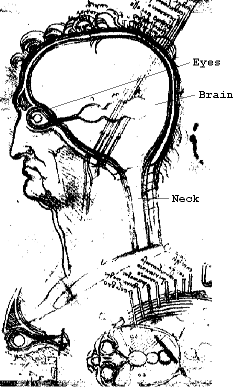Jan 14 2008
Making the Lame See and the Blind Walk
The story of a man who regained his vision after a chiropractic manipulation has been circulating around the internet, causing anyone with the slightest knowledge of human anatomy and appreciation for the truth to cringe. Here are the facts of the story, as related by the media. Doug Harkey went suddenly blind in his left eye 12 years ago. Recently, after a “routine visit” to his chiropractor, Tim Stackis, in which he received neck manipulation, Harkey noticed that his eyes were watering, first his left eye then his right eye. While wiping his right eye, and therefore occluding it, he noticed that he could see out of his left eye.
Doctor Stackis reports that he manipulated the bones in Harkey’s neck because they were out of alignment, adding:
“That interferes with the messages and energy the brain sends down to the rest of the body.”
There is no report of Stackis saying directly that his manipulation restored Harkey’s sight, and he is reported to be “surprised” by this outcome. Harkey himself credits the manipulation with the return of his sight, saying:
“He has miracle hands, I guess.”
How should we interpret this sequence of events? First, let us dispense with any notion that chiropractic manipulation of the neck can restore lost vision. I will refer to this highly detailed anatomical drawing by Leonardo DaVinci, which I have labeled for convenience, to demonstrate that the pathway from the eyes to the brain is fairly direct and does not pass anywhere near the neck. There is simply no biological mechanism for neck manipulation to restore vision to one or both eyes.
manipulation of the neck can restore lost vision. I will refer to this highly detailed anatomical drawing by Leonardo DaVinci, which I have labeled for convenience, to demonstrate that the pathway from the eyes to the brain is fairly direct and does not pass anywhere near the neck. There is simply no biological mechanism for neck manipulation to restore vision to one or both eyes.
Stackis’s comment about “messages and energy” is a reference to the chiropractic religious belief that a life energy, which they call innate intelligence, flows from god, to the brain, and then through the spinal cord and nerves to the whole body, maintaining health. Those chiropractors who still adhere to this strange dogma, sometimes referred to as “straight chiropractors,” further believe that subluxations – displacements in the spinal column that cannot be objectively demonstrated – block the flow of innate intelligence and cause disease.
Interestingly, even within this bizarre pre-scientific belief system manipulating the neck should not influence vision – if innate intelligence flows through the spinal cord and nerves it would not have to go through the neck to get to the eyes. So in order to believe this claim you would also have to adhere to some alternate version of neuroanatomy.
It is interesting to note that D.D. Palmer, the inventor of chiropractic (by which I mean he made it up out of his own magical thinking and wild speculation) based his ideas on a single case observation in which he believed to cure a patient of deafness by manipulating his neck. The anatomical pathways responsible for hearing do not travel through the neck anymore than those for vision do. Those this new case is strangely reminiscent of the origins of chiropractic itself.
So if chiropractic did not restore Harkey’s vision, what did? I have access to a dearth of medical information on this case, so I can only speculate, but numerous possibilities suggest themselves. The assumption that the manipulation restored Harkey’s vision is nothing but a post-hoc ergo propter-hoc logical fallacy, assuming that because A follows B that A was caused by B. Because a causal connection is extremely implausible (a politically correct way of saying “impossible”) even an extreme coincidence is a more likely explanation for the association.
However, I don’t think we have to postulate an extreme coincidence, a minor one will do. The story reports that the chiropractic visit was “routine” so it seems that Harkey frequently visited his chiropractor. Therefore, any time his vision improved would likely to be temporally close to a visit to his chiropractor.
Further, we do not know when Harkey’s vision improved, only when he noticed it improved. He reports that he did not notice it until he closed his right eye, so presumably his improvement may have occurred even before his visit to the chiropractor. It’s probable that his vision was slowly improving for months, in fact. It may seem strange that someone would not know if they can see out of one eye or not, but I have seen this myself multiple times. In fact I had a patient who was completely unaware that they were totally blind in one eye, until I did a formal exam of their vision.
So the timing is uncertain and not all that compelling or coincidental. But that aside, what did cause the improvement in Harkey’s vision? I don’t know, largely because I don’t know why he lost the vision in his left eye to begin with. There are a number of neurological and opthalmological causes for rapid or sudden loss of vision in one eye, and most allow for spontaneous recovery or improvement over time. We need not invoke miraculous or highly implausible causes to explain Harkey’s improvement.
This story is not an example of the healing powers of chiropractic. Rather it is a story about how easily belief and poor thinking leads to false and outlandish conclusions, and how readily the media will spread such stories without providing any helpful analysis. The story is ironically just another example of how anecdotes are more misleading then they are helpful.






